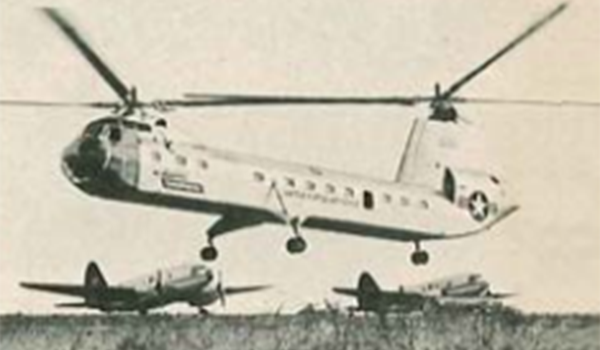
Looking Back / Army Aviation, January 1956: FORT WORTH, TEXAS—Tomorrow’s helicopter is on display today at Bell Aircraft Corporation’s Fort Worth plant.
Labelled as the Bell XH-40, is a prototype that emerged the winner of the Army’s utility helicopter design competition. Bell’s single-rotor, turbine-powered craft is capable of matching the climbing performance of some World War II fighters, together with the get up and go of many of today’s light airplanes.

YH-16
A detailed, full-scale mock-up model of the radically different military helicopter was unveiled late in November, more than three months ahead of schedule, for a going-over by a seven-man Mock-up Inspection Board and some 70 Air Force, Army, Navy and civilian advisors and observers. The XH-40 incorporates features both of a revolutionary nature as well as those of a time-tested variety.
Designed for frontline service, Bell’s new offering boasts a low silhouette, a compact configuration, and exceeds the load-carrying capabilities of rivals in its class. The XH-40 was constructed for the easy repair and/or replacement of parts when operating in the field. And, without special tools.
The XH-40 is the first helicopter to provide in-flight blade tracking and, features all-metal rotor blades, a new rotor hub design and the incorporation of a free-wheeling turbine engine resulting in significant savings in weight, wear and maintenance time. Bell engineers predict that the XH-40 will be the first helicopter to have a 1,000 hour flight period between overhauls, compared to the present-day major overhaul period of 600 hours available only with the Bell H-13.
Other unique features designed into the helicopter include permanent work platform and hoist mountings, built-in hub wrench, and simplified structural breakdown for quick and easy field maintenance and repair.
Source: See page 9, “Widespread Debuts,” Vol. 4, No. 1, Army Aviation, January 1956.
Addendum: The YH-16 came out in 1954. The Air Force was seeking a long-range (1,432 miles) helicopter for rescue duties, able to pick up downed bomber crews. The initial version, YH-16, featured a pair of Pratt & Whitney R 2180-11 piston engines, each able to generate 1,650 hp. The YH-16A featured two Allison YT38-A-10 gas turbine power plants of 1,650 hp each. Top speed was 123 mph, with cruising at 110 mph. Range was only 230 miles, hardly up to what the Air Force requested.[1]
The Army, too, saw the H-16 as that large-scale military transport. The long-legged landing gear, for instance, provided that ground clearance for external loads and/or pods, which could have been affixed to the H-16’s flat underside. With detachable pods, both troops and their equipment could be hauled simultaneously.
The YH-16A set an unofficial speed record of 166 mph. Unfortunately on January 5, 1956, 3:55 PM, a YH-16A prototype crashed, near the Delaware River, killing test pilots Harold Peterson and George Callaghan. It is reported that “the aft rotor desynchronized, collided with the forward rotor and the aircraft broke up in flight. It crashed at the Mattson Farm on Oldman’s Creek Road, near Swedesboro, New Jersey, and was completely destroyed.”[2] Not long after both the Air Force and Army ended any further interest in the H-16 project.
[1] In the “Piasecki Aircraft Corporation, Pioneers in Vertical Flight, YH-16, YH16A,” corporate booster for the H-16, horsepower of the Turbo-Transporter is noted at 1,800 horsepower for each Allison YT38-A-10 powerplant, with a maximum speed of 146 mph and a cruising speed of 140.
[2] See page 1, 5 January 1956, Piasecki H-16, This Day in Aviation, Important Dates in Aviation History.
Sources: Army Aviation: Cub to Comanche, Army Aviation Publications, Inc., Westport, Ct., 1992.
Piasecki Aircraft Corporation, Pioneers in Vertical Flight, YH-16, YH-16A.
Piasecki Aircraft, Data Sheet, YH-16, YH-16A, Piasecki Aircraft Corporation, Essington, PA., piasecki.com/wp-content/uploads/2018/12/YH-16-YH…
Swope, Bryan R., This Day in Aviation, Important Dates in Aviation History, Piasecki H-16: 5 January 1956.
























